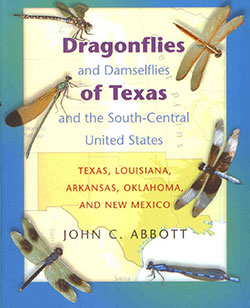Dragonflies and Damselflies of Texas and the South-Central United States
By John C. Abbott – (2005)
 344 pages; matt art paper, with 438 colour photos on 64 plates, 18 monochrome photos on 3 plates, 27 monochrome plates of technical illustrations & 2 main maps
344 pages; matt art paper, with 438 colour photos on 64 plates, 18 monochrome photos on 3 plates, 27 monochrome plates of technical illustrations & 2 main maps
Soft Cover: 18.6cm x 23.5cm.
ISBN: 0-691-11364-5
Princeton University Press, New Jersey USA.
This is a great book and not just for anyone interested in the odonates of North America but for anyone interested in the odonates in general. All 263 species known to the region (more than half of the 433 odd species known to the United States) have been well researched and are expertly covered here.
The opening introduction includes life ecology, notes on ancient odonate fossil history, their global distribution and harmlessness to humans, habitats and zoogeography, anatomy, flight seasons, conservation and their importance as bio-indicators with tips on studying and photographing odonates. The section on habitats provides in depth data and is particularly well explained.
The species are presented in two main chapters divided by their suborders and appropriate genus. There is a brief description of each genus with indication of local (relevant to the book) species numbers only. Each species has a very full description including its common name, scientific name and author, measurements in millimeters, local and global distribution, flight season, identification, similar species, habitat and discussion and a small white map with local areas of distribution shaded in grey.
Overall this is a very inspiring book and the author has done a marvelous job. I am however, not sure I agree with the authors comments on page 151 when speaking about the ‘Petaltails’, suggesting there are only 4 species in Australia and New Zealand. As far as I know there are at least 5 species in Australia and 2 species in New Zealand.
That aside, this book presents many excellent colour photos, well written text packed full of information and offered in simple terms aimed at a very distinct audience of one to encourage and warmly embrace the amateur odonate enthusiast and the growing interest among the general public itself. Further and very importantly, it also brings to the reader’s attention the benefits the odonates bring to us as bio-indicators also including the prevention of many human lives lost annually around the globe thru malaria and dengue fever as biological insect pest control managers.
Rod Rice
Principal Reviewer
Nature & Travel Books
